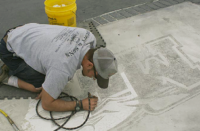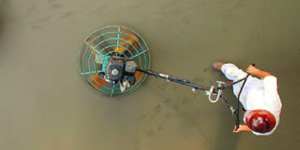The air temperature is 97 degrees F, the concrete arrives late and it turns out it’s a hot load. A set retarder is added, which only makes matters worse. The concrete now sits for eight hours before you can do anything with it.
The second load arrives on time, and you are forced to stamp that in 30 minutes. You get the job finished, but because of the curve ball you were handed, through no fault of your own, the final color is wrong and the client is not happy. Now what?
Stop!
In close to 20 years of troubleshooting, I’ve never seen a poorly thought-out repair end well. Slow down, take a deep breath, and tap into your resources.
Know who you’re going to call
Slowing down can range from five minutes to five months, depending on the situation. The point being, take the time to think before you act. I realize the pressure of the homeowner pushing for answers or the GC yelling about charge backs for lost time, but a knee-jerk response can often turn a small issue into a catastrophe. This is where your resource network comes into play.
Step five in the “Seven Steps to Success Before You Start Any Project” is “Build a Resource Network.” It can range from your own personal experience to asking others for help. That stack of business cards from established and trusted industry specialists that you’ve been collecting for years is a good place to start.
Product representatives, distributor sales staff, other installers and artisans in related trades are often the most common people found in decorative concrete applicator resource networks. You can go looking when a problem occurs, but once again, planning ahead can save time and money when things turn ugly on a project.
I need to stress how your local decorative distributor’s sales and counter staff are invaluable in this situation. They quite often can get you in touch with people in the know when problems occur.
Other places to look include social media pages, web sites, trade shows— such as the Concrete Decor Show and World of Concrete— industry meetings and publications like this one you’re reading right now. Too many times I’ve seen a small problem turn into a huge problem because an applicator didn’t know where to look or who to talk to.
Social media has its place
As a side note, the internet has provided a quick and easy means for soliciting advice for problems in the field. There are dozens of social media sites and pages that are full of eager contributors all willing to share advice on how to repair your issue.
Social media has its place, and I support sharing ideas online, but I also caution anyone soliciting advice from unknown sources. Ask 10 people on a social-media help page the same question and you’re probably going to get 10 different responses. There’s a good chance you can come away more confused than when you started, and sometimes the advice is just plain wrong.
If you do plan on following advice provided online, check out the source, get a second opinion, and always do a sample or mock-up to confirm the results are satisfactory. There are some really smart people who contribute regularly to social media pages and offer sound advice. I suggest you find them and add them to your resource network.
Back to the problem
Back to our stamped concrete color issue. The installer knew he had a problem, but he didn’t panic. He finished the concrete as best as possible focusing on the texture and detail— the things that are really hard to repair once the concrete has set.
He communicated all the facts with his client, managed expectations and committed to finding a solution. He then turned to his resource network, which he had developed over years of attending trainings and continued education, and started the process of figuring out a plan to restore the color. After some texts, phone calls and emails, products and solutions were discussed and a plan was put into place.
Within 48 hours, he was back on the job testing a solution on a small area. In this case a combination of water-based stains and color wash was the best option. As is the case in many repair situations, the manufacturers’ mixing and application guidelines went out the window and the artistic license took over.
The products were both diluted to achieve a very light and natural translucent color that allowed the concrete’s base color to show through, while creating accents and highlights that covered the original color inconsistency. The concept of diluting tints, stains and color wash products also allows for multiple light coats to be applied. This allows the applicator to gradually see the changes and avoid the “fake painted” appearance.
Marrying art and science
It’s important to note that most tints, stains and washes require a sealer to lock in the color, and it is only as good as the maintenance program that must follow. If the sealer “walks off” so does the color. No repair is as good as the original color, but if installed well and maintained properly, it can last a long time. In this case the repair was satisfactory to the client, and by the next day the entire project was recolored and sealed.
Decorative concrete is as much science as it is art. This industry is not for everyone. I’ve seen many installers lured into a job because they see dollar signs and the lure of easy money, only to realize they are in way over their head, and the real work on a decorative project starts after the concrete is placed.
I have the highest respect for those artisans, large and small, who have that eye for detail, produce great work and understand issues will arise — it’s the nature of the business. How they deal with these issues is a big part of what sets them apart from the rest.

















